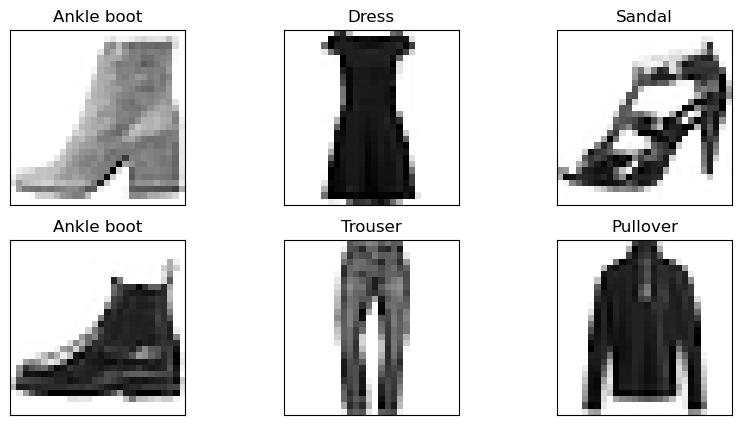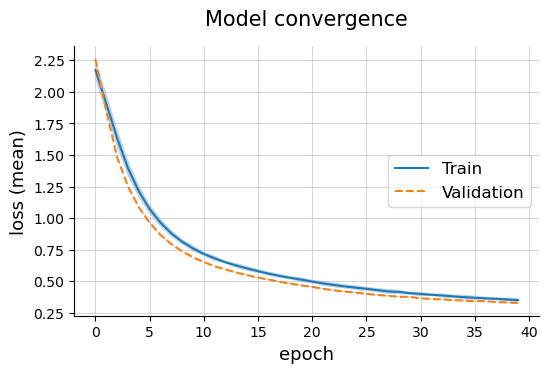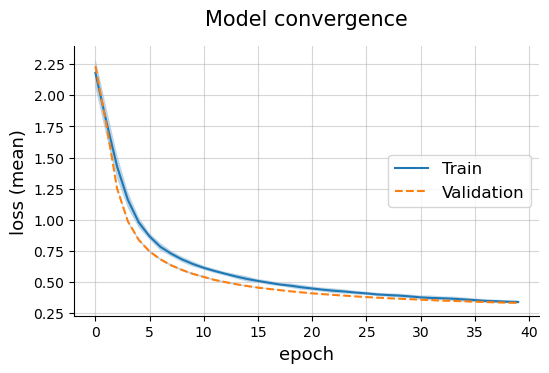Example 6. Testing different CNN architectures
import os
import torch
import pandas as pd
import numpy as np
import matplotlib.pyplot as plt
from sklearn.model_selection import train_test_split
from torch.utils.data import DataLoader
from torchvision import datasets, transforms
from tqdm import tqdm
# GOJO libraries
from gojo import deepl
from gojo import plotting
from gojo import core
from gojo import util
DEVICE = 'cuda'
C:Usersfgarciaanaconda3envsmlv0libsite-packagestqdmauto.py:21: TqdmWarning: IProgress not found. Please update jupyter and ipywidgets. See https://ipywidgets.readthedocs.io/en/stable/user_install.html from .autonotebook import tqdm as notebook_tqdm
Data loading
# FashionMNIST labels (https://github.com/zalandoresearch/fashion-mnist)
labels = {
0: 'T-shirt/top',
1: 'Trouser',
2: 'Pullover',
3: 'Dress',
4: 'Coat',
5: 'Sandal',
6: 'Shirt',
7: 'Sneaker',
8: 'Bag',
9: 'Ankle boot'
}
# define the transformation used to load the images
transform = transforms.Compose([
transforms.ToTensor(),
])
# download the FashionMNIST datasets (train/test)
train_dataset = datasets.FashionMNIST(
root=os.path.join(os.path.expanduser('~'), 'test_datasets', 'pytorch'),
train=True, transform=transform, download=True)
test_dataset = datasets.FashionMNIST(
root=os.path.join(os.path.expanduser('~'), 'test_datasets', 'pytorch'),
train=False, transform=transform, download=True)
# plot some examples
np.random.seed(1997)
fig, axes = plt.subplots(2, 3, figsize=(10, 5))
for i, ax in enumerate(axes.flatten()):
img, label = train_dataset[np.random.choice(len(train_dataset))]
img_np = img.numpy().squeeze(0)
ax.imshow(img_np, cmap='Greys')
ax.set_xticks([])
ax.set_yticks([])
ax.set_title(labels[label])
plt.show()

# separate the training data into train (85%) and validation (15%)
train_dataset, valid_dataset = torch.utils.data.random_split(
train_dataset,
[
int(len(train_dataset) * 0.85),
int(len(train_dataset) * 0.15)
],
torch.Generator().manual_seed(1997)
)
print('Train: %d' % len(train_dataset))
print('Valid: %d' % len(valid_dataset))
print('Test: %d' % len(test_dataset))
# create the dataloaders
train_dl = DataLoader(
train_dataset,
batch_size=2048, shuffle=True)
valid_dl = DataLoader(
valid_dataset,
batch_size=4096, shuffle=False)
test_dl = DataLoader(
test_dataset,
batch_size=4096, shuffle=False)
Train: 51000
Valid: 9000
Test: 10000
Vanilla CNN
v_cnn = torch.nn.Sequential(
torch.nn.Conv2d(1, 8, (3, 3)),
torch.nn.ReLU(),
torch.nn.BatchNorm2d(8),
torch.nn.Conv2d(8, 16, (3, 3)),
torch.nn.ReLU(),
torch.nn.BatchNorm2d(16),
torch.nn.MaxPool2d(2),
torch.nn.Conv2d(16, 32, (3, 3)),
torch.nn.ReLU(),
torch.nn.BatchNorm2d(32),
torch.nn.MaxPool2d(2),
torch.nn.Conv2d(32, 64, (2, 2)),
torch.nn.ReLU(),
torch.nn.BatchNorm2d(64),
torch.nn.AvgPool2d(2),
torch.nn.Flatten(),
torch.nn.Linear(256, 64),
torch.nn.Dropout(0.2),
torch.nn.ReLU(),
torch.nn.Linear(64, 10),
)
print('Number of model trainable parameters: %d' % util.tools.getNumModelParams(v_cnn))
Number of model trainable parameters: 31482
output_v_cnn = deepl.fitNeuralNetwork(
deepl.iterSupervisedEpoch,
model=v_cnn,
train_dl=train_dl,
valid_dl=valid_dl,
n_epochs=40,
loss_fn=torch.nn.CrossEntropyLoss(),
optimizer_class=torch.optim.Adam,
optimizer_params={'lr': 0.0001},
device=DEVICE,
)
Training model...: 100%|███████████████████████████████████████████████████████████████| 40/40 [02:06<00:00, 3.17s/it]
Model convergence
plotting.linePlot(
output_v_cnn['train'],
output_v_cnn['valid'],
x='epoch', y='loss (mean)', err='loss (std)',
labels=['Train', 'Validation'],
title='Model convergence',
ls=['solid', 'dashed'],
style='default', legend_pos='center right'
)

Model evaluation
# make model predictions
v_cnn = v_cnn.eval()
y_hat = []
y_true = []
with torch.no_grad():
for X, y in tqdm(test_dl, desc='Performing predictions...'):
# convert logits to probabilities
_y_hat = torch.nn.functional.softmax(v_cnn(X.to(device=DEVICE)), dim=1).cpu().numpy()
# convert from one-hot encoding to integer-coding
y_hat.append(_y_hat.argmax(axis=1))
y_true.append(y.numpy())
y_hat = np.concatenate(y_hat)
y_true = np.concatenate(y_true)
# calculate per-class accuracy
acc_per_label = {}
for label_key, label in labels.items():
y_true_bin = (y_true == label_key).astype(int)
y_hat_bin = (y_hat == label_key).astype(int)
# compute accuracy
acc_per_label[label] = core.getScores(
y_true_bin,
y_hat_bin,
metrics=core.getDefaultMetrics('binary_classification', ['accuracy'])
)['accuracy']
print('Average accuracy: %.3f' % np.mean(list(acc_per_label.values())))
pd.DataFrame([acc_per_label], index=['Accuracy']).T
Performing predictions...: 100%|█████████████████████████████████████████████████████████| 3/3 [00:00<00:00, 8.67it/s]
Average accuracy: 0.975
| Accuracy | |
|---|---|
| T-shirt/top | 0.9656 |
| Trouser | 0.9951 |
| Pullover | 0.9651 |
| Dress | 0.9748 |
| Coat | 0.9588 |
| Sandal | 0.9922 |
| Shirt | 0.9303 |
| Sneaker | 0.9872 |
| Bag | 0.9908 |
| Ankle boot | 0.9893 |
CNN with residual connections
res_cnn = torch.nn.Sequential(
torch.nn.Conv2d(1, 8, (3, 3), stride=2),
torch.nn.ReLU(),
torch.nn.BatchNorm2d(8),
deepl.cnn.ResNetBlock(8, 16, kernel_size=3),
torch.nn.MaxPool2d(2),
deepl.cnn.ResNetBlock(16, 32, kernel_size=3),
torch.nn.MaxPool2d(2),
torch.nn.Flatten(),
torch.nn.Linear(288, 64),
torch.nn.Dropout(0.2),
torch.nn.ReLU(),
torch.nn.Linear(64, 10),
)
print('Number of model trainable parameters: %d' % util.tools.getNumModelParams(res_cnn))
Number of model trainable parameters: 37546
output_res_cnn = deepl.fitNeuralNetwork(
deepl.iterSupervisedEpoch,
model=res_cnn,
train_dl=train_dl,
valid_dl=valid_dl,
n_epochs=40,
loss_fn=torch.nn.CrossEntropyLoss(),
optimizer_class=torch.optim.Adam,
optimizer_params={'lr': 0.0001},
device=DEVICE,
)
Training model...: 100%|███████████████████████████████████████████████████████████████| 40/40 [02:00<00:00, 3.00s/it]
Model convergence
plotting.linePlot(
output_res_cnn['train'],
output_res_cnn['valid'],
x='epoch', y='loss (mean)', err='loss (std)',
labels=['Train', 'Validation'],
title='Model convergence',
ls=['solid', 'dashed'],
style='default', legend_pos='center right'
)

Model evaluation
# make model predictions
res_cnn = res_cnn.eval()
y_hat = []
y_true = []
with torch.no_grad():
for X, y in tqdm(test_dl, desc='Performing predictions...'):
# convert logits to probabilities
_y_hat = torch.nn.functional.softmax(res_cnn(X.to(device=DEVICE)), dim=1).cpu().numpy()
# convert from one-hot encoding to integer-coding
y_hat.append(_y_hat.argmax(axis=1))
y_true.append(y.numpy())
y_hat = np.concatenate(y_hat)
y_true = np.concatenate(y_true)
# calculate per-class accuracy
acc_per_label = {}
for label_key, label in labels.items():
y_true_bin = (y_true == label_key).astype(int)
y_hat_bin = (y_hat == label_key).astype(int)
# compute accuracy
acc_per_label[label] = core.getScores(
y_true_bin,
y_hat_bin,
metrics=core.getDefaultMetrics('binary_classification', ['accuracy'])
)['accuracy']
print('Average accuracy: %.3f' % np.mean(list(acc_per_label.values())))
pd.DataFrame([acc_per_label], index=['Accuracy']).T
Performing predictions...: 100%|█████████████████████████████████████████████████████████| 3/3 [00:00<00:00, 8.13it/s]
Average accuracy: 0.973
| Accuracy | |
|---|---|
| T-shirt/top | 0.9621 |
| Trouser | 0.9957 |
| Pullover | 0.9561 |
| Dress | 0.9771 |
| Coat | 0.9552 |
| Sandal | 0.9910 |
| Shirt | 0.9275 |
| Sneaker | 0.9868 |
| Bag | 0.9924 |
| Ankle boot | 0.9903 |